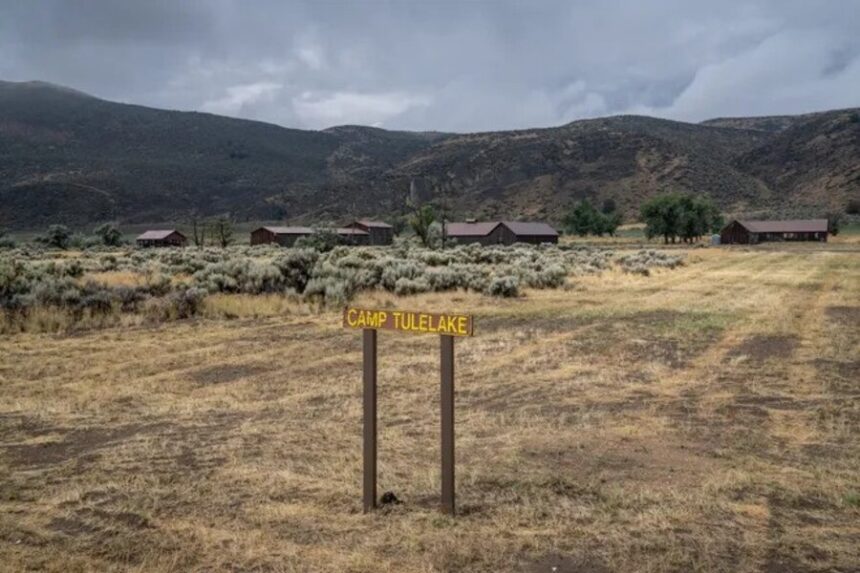EL PASO, Texas — The Department of Homeland Security is expanding immigration detention at Fort Bliss, converting part of the U.S. Army installation into what officials describe as the nation’s largest ICE detention complex. The new facility, known locally as Camp East Montana, is designed to hold up to 5,000 people at a projected cost of $1.2 billion. Visible from El Paso’s Montana Avenue and adjacent to ICE’s local headquarters, the white-tent encampment is central to the administration’s strategy to increase detention capacity as arrests rise along the border and in the interior. As of mid-August, roughly 1,000 men were being held there, according to Rep. Veronica Escobar, the Democrat whose district includes the base.
Homeland Security says the expansion targets serious offenders and accelerates removals. Tricia McLaughlin, DHS assistant secretary for public affairs, blasted comparisons to World War II incarceration as “deranged and lazy,” arguing that ICE is focusing on “the worst of the worst — including murderers, MS-13 gang members, pedophiles and rapists.” Yet federal snapshots and independent analysis paint a more mixed picture of who is being detained. A June review by the Cato Institute of government data found ICE arresting four times more non-criminals each week than people with convictions, and ICE’s own mid-August figures indicated that 45% of roughly 59,000 people in custody had no criminal record or pending charges.
Fort Bliss’s role has struck a deep nerve with historians and families whose relatives were confined during World War II. The base was one of several military sites used to hold people labeled “alien enemies,” including first-generation Japanese immigrants. Densho, a nonprofit documenting wartime incarceration, notes the compound then had double barbed-wire fencing; records compiled by the nonprofit database Ireizō show at least 113 Japanese immigrants were sent to Fort Bliss before being transferred elsewhere, an early chapter in a system that ultimately swept up more than 125,000 people of Japanese ancestry, most of them U.S. citizens. “For the vast majority, there were no accounts of wrongdoing other than being seen as ‘enemy aliens,’” said Karen Umemoto, who directs UCLA’s Asian American Studies Center.
That history feels personal to Brian Niiya, historian and content director at Densho, whose grandfather — a newspaper editor in Honolulu — was arrested on Dec. 7, 1941, and cycled through six camps over two years. “It’s important to look to this past to maybe try to understand what’s going on in the present and what the results could be,” he said. For Mike Ishii, executive director of Tsuru for Solidarity, parallels are less about identical legal frameworks than about lived experience: authorities “coming in and removing people from their homes, from their workplaces, often with no explanations.” He added, “Right now, it’s very frightening for people. In 1941, it was also frightening.”
The legal backdrop is complicated. After Pearl Harbor, President Franklin D. Roosevelt invoked the 1798 Alien Enemies Act to detain people and seize property. The current administration has likewise pointed to that law in designating some immigrants as “alien enemies” for expedited deportation, though the Supreme Court has blocked certain removals. Supporters argue that a larger, centralized facility at a secure military site improves safety and efficiency. Critics counter that relying on emergency powers and military bases risks normalizing mass detention of people who often have no criminal records and may have viable claims to remain.
Fort Bliss has been used for immigration operations under both parties. During the Biden administration, a privately run “emergency intake site” at the base processed unaccompanied children for release to sponsors in the United States. That operation drew protests from survivors and descendants of WWII incarceration, and later came under scrutiny in a 2022 federal report that documented problems involving child safety and case management. Today, the fortified Camp East Montana complex functions as a high-volume intake and holding hub; plywood signs at the approach warn that all vehicles are subject to search and prohibit cameras and phones.
Pentagon officials have embraced the expansion as part of a whole-of-government deportation campaign. At an Aug. 7 briefing, Defense Department spokesperson Kingsley Wilson said Fort Bliss would be “the largest federal detention center in history for this critical mission, the deportation of illegal aliens.” Local leaders and civil-rights groups are already calling for more transparency around costs, contractors, conditions, and due-process protections. With construction and intake accelerating, litigation over detention standards and eligibility for release is likely, along with congressional oversight fights and continued protests.
For readers asking what happens next, the key variables are who is detained, under what legal authority, and with what safeguards. If the population continues to include large numbers of people without criminal histories, pressure will grow for alternatives to detention, faster case adjudication, and independent monitoring of conditions. If the facility is used primarily for individuals with serious convictions, DHS could claim vindication, though civil-liberties challenges to blanket detention policies would persist. Either way, building a 5,000-bed complex on ground linked to wartime incarceration ensures that operational choices will be judged not only by statute and statistics but also against the historical lessons many descendants say the country cannot afford to forget.




